Cumulative effect of Academician Lavrentiev
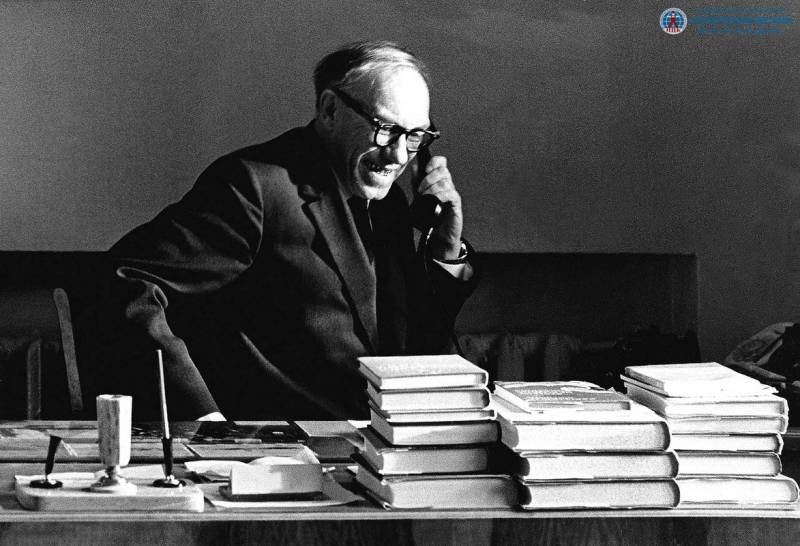
Mikhail Alekseevich Lavrentiev
Mathematician and mechanic
By the beginning of the Great Patriotic War, Mikhail Alekseevich Lavrentiev was already a world-famous scientist. A bit of great and terrible mathematics from the track record of the future academician: "descriptive set theory", "homeomorphism continuation theorem", "quasi-conformal mapping theory" and much more. But Lavrentiev was not limited to theoretical mathematics - a considerable part of the works has a quite tangible practical application. For example, in 1934, the scientist publishes a theorem in which he proves that the wing profile in the form of arcs of circles or Zhukovsky's bow has the maximum lifting force. It sounded like "extremal problem of the theory of conformal mappings". Lavrentiev worked for some time aviation questions at the Central Aerohydrodynamic Institute in the group of Sergei Chaplygin. The scientist later recalled:
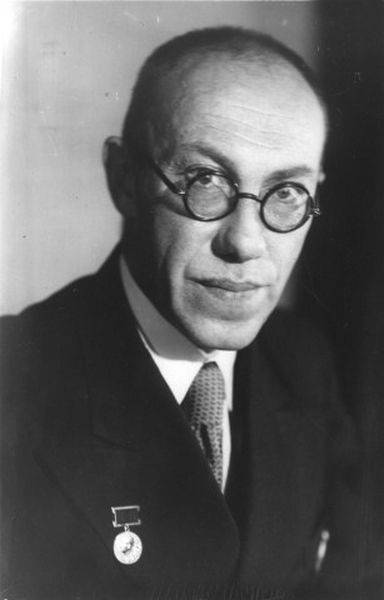
Future Academician Mikhail Alekseevich Lavrentiev
In the mid-30s, the scientist became twice a doctor of science - first technical, and later - physical and mathematical. Academic degrees are awarded to Lavrentiev without defending a dissertation on the basis of "the totality of scientific merit." In the future, a skillful combination of mathematical theory and practical results became Mikhail Alekseevich's trademark. Just before the war - in 1939 - Lavrentiev was appointed director of the Institute of Mathematics of the Academy of Sciences of the Ukrainian SSR in Kyiv. At the same time, the scientist does not lose touch with Moscow and remains a professor at Moscow State University.
The evacuation to Ufa posed purely practical tasks for the mathematician - now there were no civilian problems, all topics related to the defense industry. Lavrentiev took up the theory of explosion, first of all, the hydrodynamic theory of cumulation. It is immediately necessary to clarify that the cumulative effect that turned military science upside down in the 30s is not Lavrentiev's discovery. The phenomenon was discovered in the second half of the 1914th century. and for the time being did not find an intelligible explanation. Indeed, it was very difficult to understand how covering a recess in an explosive with a steel sheath and removing the charge from the piercing body increases the penetration effect. But this did not prevent the use of the cumulative effect, albeit limitedly, in mining. The first patent for cumulative ammunition dates back to XNUMX, but the real heyday of technology happened only in World War II. For the most part, cumulative shells were developed on empirical data - no country in the world had a coherent theory. Lavrentiev writes in this regard:
However, the theoretical research of Mikhail Alekseevich concerns the late period, and in Ufa purely technical tasks awaited him. The main development was aviation cumulative bombs. Here is an excerpt from the book by Yuri Yergin, the biographer of the academician and the first rector of the Bashkir University:
Lavrentyev's PTABs were produced in Ufa on the Prommetiz artel evacuated from Dnepropetrovsk. The final refinement of the design of the ammunition and the fuse AD-A was made by Ivan Aleksandrovich Larionov.
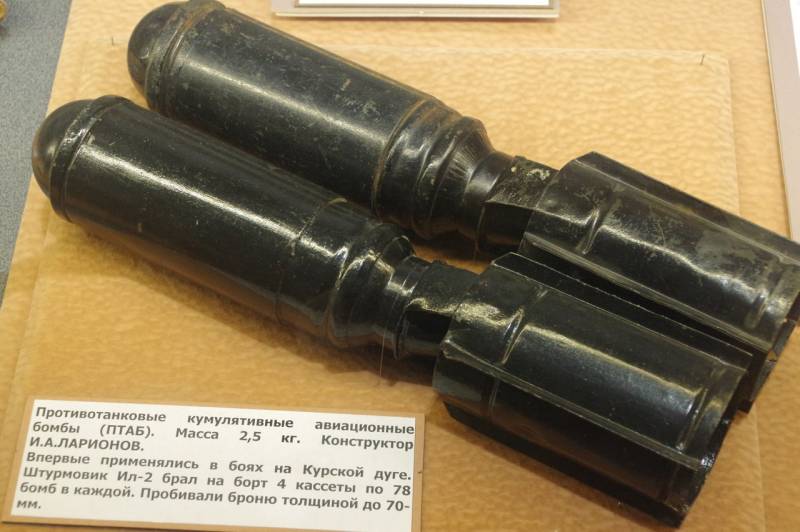
Each bomb weighed 2,5 kg and pierced up to 70 mm of armor with a cumulative pestle. This was enough to defeat the most protected tanks of the Wehrmacht - the Panther had no more than 16 mm in the roof, the Tiger had 28 mm. It's no joke, Lavrentiev came up with roof-piercing ammunition long before they became mainstream. For the first time, PTABs from Ufa were used in the Battle of Kursk, and they had a very worthy effect on the Nazis - several hundred tanks were destroyed by air strikes.
Here in Ufa, Lavrentiev deals with a wide range of problems that are not directly related to cumulative effects. Contemporaries of the scientist recall:
Interestingly, even in the difficult conditions of the evacuation, Lavrentiev does not give up mathematics and publishes a work on "solvability of the problem of solitary waves on the surface of an ideal fluid". But the main forces, of course, took away questions of a defensive nature.
Cumulative theory
In Ufa, Lavrentiev began work on the hydrodynamic theory of a cumulative explosion, and continued in Moscow and Kiev from 1944. It was a strictly secret topic - the first open publications in the world press appeared only in 1948. In the mid-40s, there were two theories explaining the cumulative effect - the armor burning scheme and the spalling scheme. In accordance with the first, a jet of gas pierces the armor, the second implied a breakdown with hot metal dust. Lavrentiev empirically proved the failure of both approaches and offered the theory of liquid jets as an explanation. To do this, it is necessary to assume that the copper lining of the cumulative projectile and armor are essentially incompressible liquids, albeit very viscous ones. Lavrentiev subsumed the dynamic model of an incompressible fluid under the hypothesis, and it turned out that it surprisingly explains the entire physics of a cumulative explosion. But some were funny. Mikhail Alekseevich recalls:
In practice, Lavrentiev managed to prove the truth of the theory in the village of Feofaniya, 20 km from Kyiv in 1944-1946. As the author later recalled, the position of vice-president of the Academy of Sciences of the Ukrainian SSR made it possible to quickly begin work in the explosive laboratory. Much had to be done literally on the knee. For example, Lavrentiev's driver made metal funnels for explosives. Charges Lavrentiev cast on an electric stove, pressed explosives on a conventional bookbinding press. About those days Lavrentiev writes:
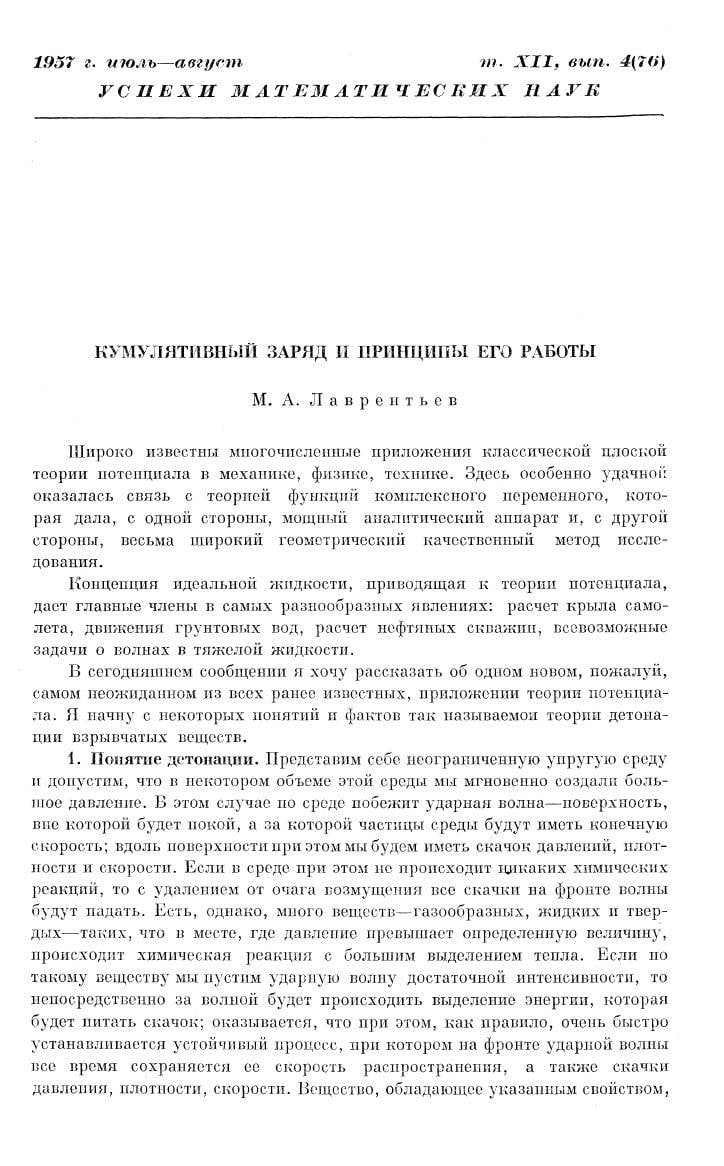
In 1949, Mikhail Alekseevich was awarded the State Prize for the theory of a cumulative explosion.
In his famous article "The shaped charge and the principle of its operation" in 1957, Lavrentiev describes the mechanics of the explosion in a peculiar way. So, a cumulative cone, after compression by an explosion and thickening of the walls,
The cumulative pestle is called a wire, which acts on the armor with a pressure of 1 million atmospheres, which is why the latter simply spreads.
Once again, it is worth emphasizing the full breadth of Mikhail Alekseevich's talent. The cumulative theory was by no means the main achievement of his scientific life. And the scientist did not live by dry mathematics alone. Lavrentiev was interested in building mathematical models of natural phenomena. A number of interesting hypotheses were expressed by him about the features of the propagation of tsunami waves, about the Novorossiysk forest, about the methods of movement of snakes and fish, about the mechanisms for the formation of wind waves and about the damping of these waves by rain. By the way, in the Novosibirsk Academgorodok, which was built under the strict guidance of the academician, the Institute of Hydrodynamics became the first operating research institute. At present, it is one of the key scientific institutions in the country dealing with the problems of explosion physics. The modern and full name of the institution is the Institute of Hydrodynamics. M. A. Lavrentiev SB RAS.
After the war, Lavrentiev did not leave applied defense research. In 1950, he studied the effects of blast waves on ships and techniques for the explosive clearance of ports. In 1953, in Sarov, he began to develop an atomic artillery shell - by that time the Soviet Union had lagged behind the United States in this topic. Three years later, an ammunition with a nuclear charge appears based on the implosion mechanism. Schematically, the Lavrentiev projectile resembled a Central Asian melon hidden inside the ammunition case.
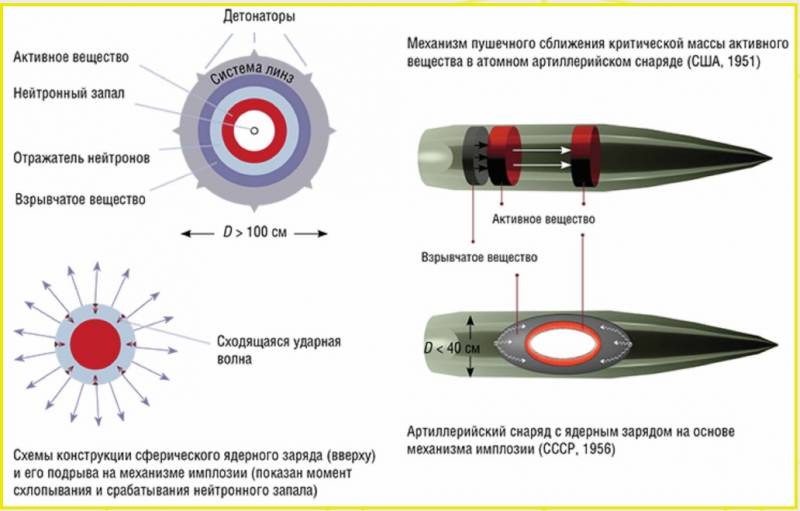
Mikhail Alekseevich passed away in 1980 at the age of 79, leaving behind a gigantic scientific and technical heritage and a whole army of students. The defense problems solved by Lavrentiev occupied an important part of the scientist's life, but were by no means the only ones. The main creation of the academician was the Novosibirsk Academgorodok, but this is already a completely different story.
Information